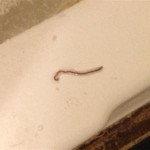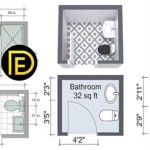How To Get Rid Of Bathroom Mould On Ceiling
Bathroom ceilings, due to their constant exposure to moisture and humidity, are susceptible to mould growth. This unsightly and potentially harmful fungus can appear as black, green, or brown spots, often accompanied by a musty odor. Addressing this problem promptly is crucial for maintaining a healthy and aesthetically pleasing bathroom.
Identifying the Cause
Before attempting mould removal, identifying the root cause is essential for preventing recurrence. Common culprits include inadequate ventilation, leaking pipes, and consistently high humidity levels. Inspect the ceiling for signs of leaks, checking for water stains or dripping sounds. Ensure the bathroom fan is functioning correctly and used regularly, especially during and after showers or baths.
Necessary Safety Precautions
Protecting oneself during mould removal is paramount. Mould spores can irritate the respiratory system and skin. Always wear protective gear, including: * Gloves: Nitrile or rubber gloves are recommended. * Mask: An N95 respirator mask is ideal for preventing spore inhalation. * Eye protection: Goggles or safety glasses will shield eyes from splashes. * Protective clothing: Cover exposed skin with long sleeves and pants.
Cleaning Solutions for Mould Removal
Several effective cleaning solutions can eliminate bathroom ceiling mould. * White vinegar: An eco-friendly and effective option. * Bleach solution: A potent solution but requires careful handling and dilution. * Commercial mould cleaners: Available in various formulations, some specifically designed for bathrooms. * Baking soda: Another natural cleaning agent with mild abrasive properties.
Applying the Cleaning Solution
The application method varies depending on the chosen cleaning solution and the extent of mould growth. For light mould, a spray bottle can be used to apply the solution directly to the affected area. For heavier infestations, a scrubbing brush or sponge may be necessary. Always ensure adequate ventilation during the cleaning process. * Spray Bottle Method: Saturate the mouldy area with the chosen cleaning solution, allow it to sit for the recommended dwell time (usually 10-30 minutes), and then scrub gently. * Sponge/Brush Method: Apply the cleaning solution to a sponge or brush and scrub the affected area thoroughly. * Heavy Infestation: For severe mould growth, professional remediation may be required.
Preventing Mould Regrowth
After successful mould removal, implementing preventative measures is crucial. This includes addressing the initial cause of the mould growth. Key preventative steps are: * Improve ventilation: Ensure the bathroom fan is operational and used consistently. Consider installing a dehumidifier if necessary. * Repair leaks promptly: Address any plumbing issues that contribute to moisture buildup. * Control humidity: Reduce humidity levels by opening windows or using a dehumidifier. * Regular cleaning: Regularly clean the bathroom ceiling with a suitable cleaning solution to prevent mould from establishing itself.
Dealing with Persistent Mould
If mould returns despite cleaning efforts, it may indicate a more significant underlying issue. This could include hidden leaks or structural damage. In such cases, consulting a professional mould remediation specialist is recommended. They can assess the situation, identify the source of the problem, and implement appropriate solutions.
Natural Ventilation and Its Importance
Proper ventilation plays a vital role in preventing mould growth. Bathrooms, being inherently humid environments, benefit significantly from effective ventilation. * Open windows: Whenever possible, open windows to allow fresh air circulation. * Exhaust fans: Ensure the bathroom exhaust fan is functional and used during and after showers and baths. Consider upgrading to a more powerful fan if necessary. * Dehumidifiers: In climates or homes prone to high humidity, a dehumidifier can effectively reduce moisture levels.
Professional Mould Remediation
For extensive mould growth, particularly if it covers a large area or appears deeply embedded in the ceiling material, professional remediation is the safest and most effective course of action. * Expertise: Professionals possess the knowledge, equipment, and experience to handle complex mould issues. * Thorough removal: They utilize specialized techniques to ensure complete mould removal, including addressing hidden mould within the ceiling structure if necessary. * Safety: Professionals adhere to safety protocols and utilize appropriate protective gear to minimize exposure to mould spores. * Prevention: They can offer advice and implement solutions to prevent future mould growth.

Bathroom Ceiling Mold Removal When To Clean Call Branch Environmental

Cleaning Mold From Bathroom Ceilings Like A Pro Lovetoknow

How To Remove Black Mold From A Bathroom Ceiling

Cleaning Mrs Hinch Fans Share Tips To Remove Ceiling Mould Express Co

Don T Let Mould Take Over How To Remove It From Your Ceiling

What Is The Best Way To Remove Mold From Bathroom Ceiling

How To Remove Mould From Your Bathroom Ceiling Cleanipedia Za

How To Get Rid Of Mold On Your Bathroom Ceiling Aqa

Black Spots On The Bathroom Ceiling Flood Water Damage Honolulu Oahu Hawaii Md Restoration

How To Get Rid Of Mould From Your Ensuite Ceiling Independent Ie







